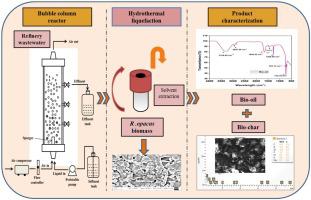Journal of Water Process Engineering ( IF 6.3 ) Pub Date : 2020-07-07 , DOI: 10.1016/j.jwpe.2020.101462 Tanushree Paul , Arindam Sinharoy , Kannan Pakshirajan , G. Pugazhenthi

|
In this study, a bubble column reactor (BCR) was evaluated for producing lipid rich biomass of Rhodococcus opacus using refinery wastewater as the substrate. The biomass obtained was used for bio-oil production by hydrothermal liquefaction (HTL) process. Initially, the effect of three media constituents viz. NH4Cl, KH2PO4, and Na2HPO4 and three physicochemical parameters i.e., pH, agitation and temperature on refinery wastewater treatment by R. opacus was studied employing Placket Burman experimental design. From the results, it was observed that variation in the levels of these parameters does not have any significant effect on the wastewater treatment efficiency indicating the robust nature of R. opacus in treating refinery wastewater. During the continuous wastewater treatment using BCR, a very high chemical oxygen demand (COD) removal efficiency of 97 % was obtained along with 2.4 g L−1 of biomass and 1.33 g L−1 lipid yield. The lipid rich bacterial biomass was later subjected to HTL treatment which resulted in production of bio-oil with 26.5 % yield on biomass. Detailed characterization of the bio-oil revealed that it primarily contains different complex organic hydrocarbons. Characterization of solid residue (bio-char) obtained as a byproduct of HTL process contained a high amount of carbon (41.8 %) of large porosity and many active groups over its surface indicating its potential high application value. Overall, this study serves as an excellent example of zero waste strategy for recovering energy in the form of bio-oil from industrial wastewater.
中文翻译:

使用鼓泡塔生物反应器中的炼油厂废水生产高脂细菌生物质,以通过水热液化进行生物油转化
在这项研究中,使用精炼废水作为底物,对鼓泡塔反应器(BCR)进行了评估,以生产不饱和红球菌的富脂质生物质。获得的生物质通过水热液化(HTL)工艺用于生物油生产。最初,三个媒体成分的作用即是。NH 4 Cl,KH 2 PO 4和Na 2 HPO 4以及三个物理化学参数,即pH,搅拌和温度对不透明红景天处理炼油废水的影响是使用Placket Burman实验设计进行研究的。从结果中观察到,这些参数水平的变化对废水处理效率没有任何显着影响,表明不透明红景天在处理炼油废水中具有很强的特性。在使用BCR的连续废水处理过程中,获得了非常高的97%的化学需氧量(COD)去除效率以及2.4 g L -1的生物量和1.33 g L -1脂质产量。富含脂质的细菌生物质随后进行HTL处理,从而产生生物油,其生物质收率为26.5%。对生物油的详细表征表明,它主要包含不同的复杂有机碳氢化合物。作为HTL工艺副产物获得的固体残留物(生物炭)的表征包含大量高孔隙率的碳(41.8%)和表面上的许多活性基团,表明其潜在的高应用价值。总的来说,这项研究是从工业废水中以生物油的形式回收能源的零废物策略的一个很好的例子。











































 京公网安备 11010802027423号
京公网安备 11010802027423号